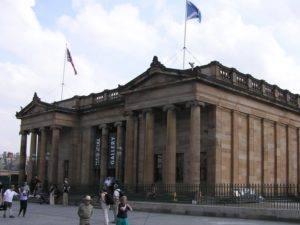It’s a bigger question than you realize. Still, we are a species that enjoys classifying things; putting things into cubbyholes. So let’s live up to our socio-biological programming, shall we?
Let’s define “MUSEUM”. What is this thing?
According to the International Council of Museums (ICOM), a museum is…
a non-profit, permanent institution in the service of society and its development, open to the public, which acquires, conserves, researches, communicates and exhibits the tangible and intangible heritage of humanity and its environment for the purposes of education, study and enjoyment.
A mouthful. According to ICOM, a museum must do ALL of these things to be a museum. There are for-profit museums out there, and ICOM won’t call them museums. Those are galleries, perhaps. Seems to me, they might be museums, regardless of what ICOM says.
Wait, there’s another definition!
The American Alliance of Museums says museums make a…
unique contribution to the public by collecting, preserving, and interpreting the things of this world.
Well, every museum is different.
They all operate differently, under varying missions and objectives. Vastly differently, in some cases. They often have to do things a bit differently than their peers. We will list them here, as many as makes sense. We will place them all into broader categories.
Museums in General
- A baseline to make a basic determination
A museum must collect stuff, and at least try to keep it safe. The stuff has to be accessible to the public (all the public). I do not think a museum needs to display the stuff. As long as the people can get to it, and can get something out of it, a display/exhibition/etc isn’t necessary. I think the purpose of museums should be in preservation, research, and education (and purpose is important). I do not think a museum must be non-profit, though it would be a far cry better if it was.
For this baseline to work, we must define the term Stuff .
“Stuff” is culturally interesting:
- Maybe you can touch it.
- If you cannot see it, then it should impact another of your senses.
- Maybe you can hear it, of feel it. Or taste it! (I’d totally go to a museum of tastes!)
- It can be two-dimensional or three-dimensional.
- Stuff can be so small you need special technology to realize it is there.
- Stuff can be large enough to… to… I dunno, it could be really VERY big indeed. I can’t think of an upper limit there.
A museum needs to be a place you can go to. Can that be a virtual place? Sure it can! It’s the 21st Century. If I can’t have a flying car or a jetpack, then I get to have museums that only exist in the aether of webbyspace. If a museum doesn’t have “stuff” of its own to collect or protect, then it isn’t a museum. If you only display the stuff of other museums or of private collectors (and don’t actually have your own collection), you are just a gallery. Sorry.
Topical History Museums
These things relegate themselves and their mission to one topic or group of topics. The Print Museum in Houston, or the Magic Lantern Museum in San Antonio are good examples. Museums dedicated to a particular war might be in here. So are museums about individuals or specific events. The planned Maifest Museum, here in Brenham, would be a Topical Museum.
Regional History Museums
They cover the general history of a geographical area. City museums, county museums, local museums, most rural museums… I call these Regional Offices For Local Material Acquisition of Objects (ROFLMAO), or LMAO for short. An alternative, less controversial label is a Regional Repository for Cultural Heritage (RRCH), we call them a “rich”. These things hold most of the tangible and intangible cultural heritage of our country. That’s right, the tiny museum in Somerville, Texas is really important. It is the only RRCH storing the regional history of Somerville.
Historic Site Museums
This type of museum is not a conventional museum that just happens to be on or in an historic site. These museums are all about the site itself, and don’t stray much from the history of the building or place. Could be a park, a building, a house, a dry-docked ship, anything like that. It still has to collect and keep it safe.
The Alamo is a great example. It’s a shrine to that battle site. All the content is connected to the Alamo itself. The Giddings Stone Mansion in Brenham is also a good example. The building itself was collected, and they protect it at great expense. They’ve got furniture too. The public can get tours. It hits all the buttons. One could argue that Emancipation Park in Houston is a museum, in that it protects the park itself. I’d have to think about that. Maybe. Maybe not. Maybe it’s just an historic park.
The Brenham Heritage Museum is not an Historic Site Museum. We are in an historic site, but our content goes far beyond the history of our building. We are a Regional History Museum (RRCH).
Big History Museums

Scottish National Gallery, one of the Big Guys
These are the big, well-funded (relatively well-funded) museums. The Smithsonian. State Museums (not Texas though… The Bullock isn’t a museum, it’s a gallery. They only borrow their collections, they don’t have one of their own). Big University systems like the Briscoe CAH count. The National WWII Museum in NOLA is one. The system of US Army Museums counts as one huge museum, in my opinion. The Witte in San Antonio is big, and well-funded. It counts.
There’s a reason the big guys get their own category. They have their own world. They operate much, much differently. For those of you who haven’t worked at one of the “Big Guns”, you’ll just have to trust me.
They have different priorities. They have measurable marketing budgets. They have the political freedom to ignore their museum’s mission to bring huge, loaned exhibitions into their spaces for the sake of visitor revenue. Smaller museums aren’t able to hide new agendas behind the compartmentalization of a big museum. Their board can be removed from the conversation entirely… they might not even be in the same state!
These places have loyal patrons numbering in the thousands. They have awesome museum shops, stocked to the ceiling. They have major REVENUE STREAMS. Smaller museums struggle to operate in their shadow, frankly. It is a big image to live up to. Some of us do “OK”, and relish the challenge. Others maybe not.
Art Museums

Interior: British Museum, with historic art on display
Just as broad, really. But only Art: Sculpture, Painting, Pottery, Fashion, Architecture, etc… big spread. Unfortunately, art crosses paths with history so often, and in so many ways, it can be tough to pry them apart. I mean, honestly… is Da Vinci art or history? You can’t even call it “Art History” without some people arguing with you. It’s the same for architectural history, or the history of design… it’s all inextricably linked.
A museum about New York had best have some art content in it. A museum here in little ol’ Brenham, Texas had best mention Johnny Swearingen and Frank Malina. It’s the same for most museums. Conversely, an art museum exhibiting the works of the same people would be negligent not to mention Malina’s past with NASA and the JPL, his pioneering work in Paris, and his work in art publishing.
Even new art becomes art history pretty quick. Just understand that some art museums have more history on the wall than others. Design museums, architecture museums, and places like that often have tons of history on the wall. They really need to. Pure art museums tend to let the art do all the talking, and don’t put the history up at all. Perhaps maybe a blurb at the entry to the exhibition hall, if that.
To that end, I won’t create a long taxonomic list of types of art museums. You’ll know ’em when you see ’em.
Natural History Museums
Science museums, covering seemingly every subject in the scientific world, are in most cities. Unfortunately, they are not always museums. Just because it is called a museum, doesn’t mean it is one.

San Diego Zoo, and it’s a museum
If a natural science museum has a collection of some kind, then it is probably a museum… if that collection is accessible to the public in some way. Geologic specimens, taxidermy collections, insect collections, core samples, leaves, or whatever science-y bits you can think of can be part of a collection.
By far the most common type of science museum is a zoological museum… or just a Zoo for short. Yeah, zoos are museums, their collections just happen to be alive.
What isn’t a Museum?
There are some things called museums that are not museums. I think museums should be grounded in demonstrable, repeatable evidence. For science museums, this is through the scientific method. For history museums, it means a bibliography of some sort for everything you put up on that gallery wall. For art museums, the art is looking you right in the face most of the time.
Art has nothing to prove! so says every artist ever.
If a museum is predicated on a very specific belief structure designed to eliminate other belief structures, then it isn’t a museum. Are you trying to make me believe something I don’t? Maybe it’s an educational center or something. It’s not a museum.
Children’s museums are not necessarily museums. I’m certain they don’t usually have collections. I think they’re learning centers, or children’s activity centers, or something. I think they are GREAT, and they serve a very useful purpose. That said, I think many museums would love to capture more of that children’s interactive “kung fu” for their own galleries.
In Conclusion
So there is my personal definition of “MUSEUM”. I think I’ll have some disagreement from some of my peers. I hope to hear from them on the Facebook post associated with this blog entry.
